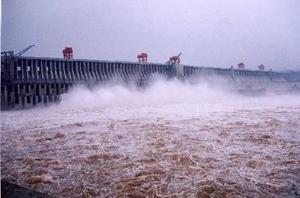InfrastructureChina's Three Gorges Dam's showing cracks
The Three Gorges Dam is China’s largest construction project since the Great Wall; the dam was hailed as an engineering feat that could withstand the worst flood in 100 years, but this year’s torrential rains have severely tested its capacity to control the surging Yangtze

Flooding Yangtze threatens Three Gorges dam // Source: greendiary.com
The Three Gorges Dam is China’s largest construction project since the Great Wall. Most Chinese praise their government’s monumental enterprise to defy the mighty Yangtze River, choke off its devastating annual floodwaters, and harness its raw power to provide cleaner energy. Such a mammoth engineering feat, they say, only serves to underscore mankind’s supremacy over nature.
Los Angeles Times’s John M. Glionna writes that critics consider the dam in less lofty terms: as Beijing’s boondoggle. With an official price tag of $25 billion — and some estimates claiming three times that much — the costliest hydropower project in history demonstrates China’s sheer arrogance in trying to tame nature’s whims, they say, never mind the 3,000 tons of garbage that have been flowing every day into the reservoir recently.
A year after the dam went into full operation, cracks are already showing in the public image of the project. This year’s torrential rains, China’s worst in a decade, have severely tested the project’s capacity to control the surging Yangtze, the world’s third-longest river.
Last month, when floodwaters poured into the dam’s 400-mile-long reservoir at 565,000 cubic feet per second, a government official acknowledged that “the dam’s flood-control capacity is not unlimited” and hinted that more severe flooding could even risk the structure’s collapse.
Glionna writes that this is a far cry from the highfalutin claims of just a few years ago. In 2003 officials boasted that the dam could withstand the worst flood in 10,000 years. In 2007 the estimate was reduced to 1,000 years. In 2008 it was dropped yet again, this time to just 100 years.
Many engineering experts are worried about this year. “The flooding is greater than anyone expected,” said John Byrne, director of the University of Delaware’s Center for Energy and Environmental Policy. “The problems that many people predicted appear to be showing themselves.”
Newspapers in China report that the reservoir’s rising water level has increased the likelihood of such hazards as landslides and earthquakes. Officials even say the structure won’t totally stop Yangtze flooding, which has killed an estimated one million people over the last century. “It can’t defeat all under heaven,” the project’s deputy operations manager said of the dam.
A project promoted by Chairman Mao Tse-tung, the Three Gorges Dam was long hailed by Communist Party officials as a crafty way to solve several complex problems with one structure. Damming the Yangtze allows seafaring ships access to the river, with the reservoir able to accommodate the deep-hulled vessels, and open up China’s landlocked interior to economic development. The clean, cheap energy generated by the dam would help wean China off coal-fired power plants, officials said.
Glionna notes that in recent years, the government has toned down its boasts on the project, which seems to have fallen out of favor in Beijing’s halls of power. When the dam officially opened in 2006, Chinese leader Hu Jintao was conspicuously absent.
Critics claim the dam’s legion of problems far outweigh its benefits. They point to the reservoir’s silt accumulation that they say will prevent the passage of the deep-sea ships. The dam has also disrupted the migratory routes of several unique fish species, they say.
Many worry the reservoir could turn into a cesspool of sewage, toxins, and other pollutants discharged from factories upstream. In recent weeks, the heavy rains have caused thousands of tons of garbage to collect at the dam, threatening to jam its locks. Although tugs and fishing boats have recently helped to collect the garbage, in some spots the trash is still so thick people can stand on it.
The dam’s biggest toll is a human one, many say. More than 1.5 million people were resettled by the project, their land submerged under the dam’s reservoir. Also lost were 1,300 important archaeological sites, many dating back 4,000 years.
Still, many residents in central Hubei province support the project. In Yichang, a city of 4 million, the airport and university are named after the Three Gorges Dam. A huge billboard proclaims: “We’re China’s City of Hydropower and Tourism.”
Good or bad, experts say, China must live with its dam. “This was an extremely ambitious project,” said William Mitsch, an environmental and natural resources professor at Ohio State University. “But it’s a lesson we see time and again — you can’t tame nature. You can build your Titanics, but sometimes they sink.”
